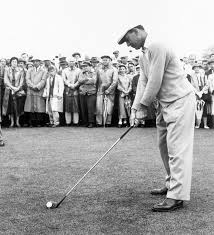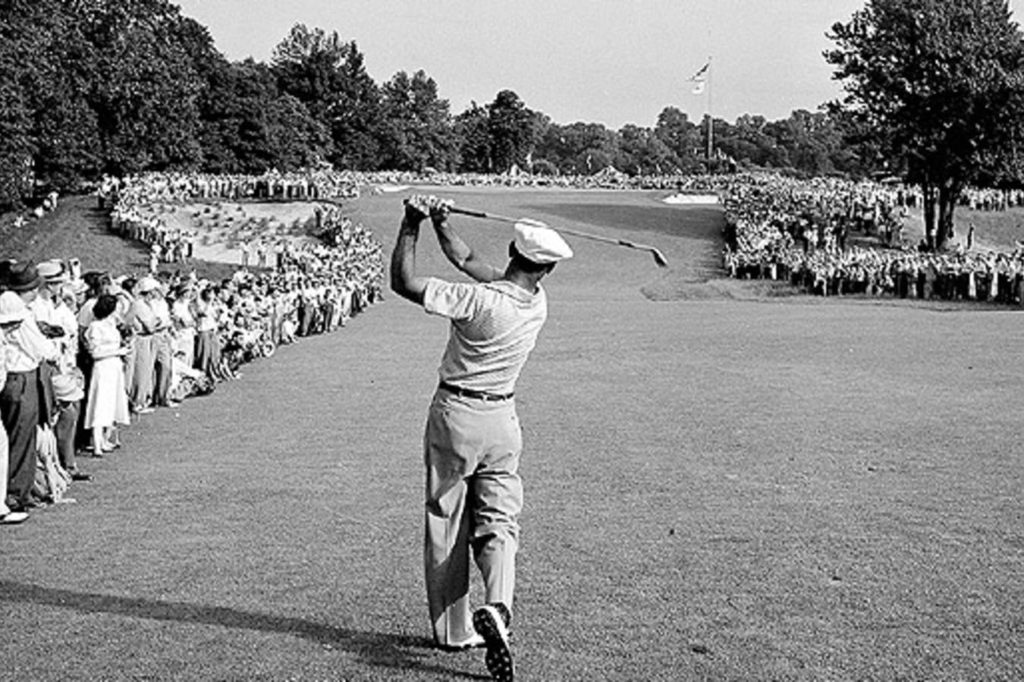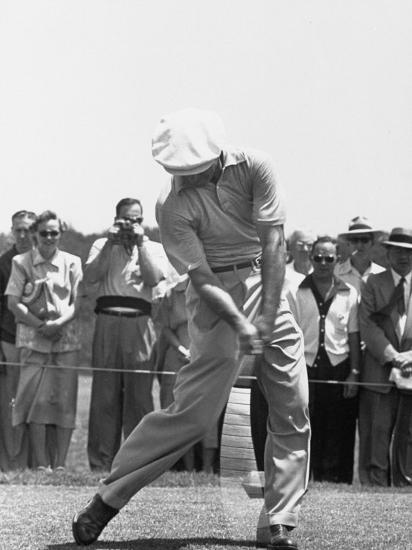In today’s world, there are plenty of options for a golfer to turn to in order to improve their game. Whether it’s lessons, YouTube videos, or recording your own golf swing, the last options often sought out are books.

However, Ben Hogan’s Five Lessons is a great option for learning the fundamentals of the golf swing, without focusing on a dozen or more separate swing thoughts. It’s the simplicity of his lessons that have led many to consider Ben Hogan’s Five Lessons to be the Holy Grail of golf literature.
Lesson 1 – The Grip
Most golfers struggle with what grip to choose and what a proper grip consists of. Hogan’s description of the grip is that of an overlap, where the pinky of the dominant hand rests between the fore finger and middle finger of the weak hand. With the most common grip today being an interlock grip, this is certainly a throwback method for gripping the golf club.
Secondly, Hogan’s emphasis on a relaxed grip, holding the club within the fingers (and which fingers apply pressure) is an excellent explanation of how the golf club is intended to be held. He describes the negative influences certain fingers have when gripping the golf club that leads to an understanding of the proper placement of pressure starting with your hands and how that is impacted throughout the golf swing.
Lesson 2 – Stance & Posture
If you’re like many high handicappers after watching a video of your golf swing, it’s easy to see that even at address you don’t resemble a scratch golfer. Maintaining a consistent stance and posture with each golf swing is critical to groove a repeatable swing, according to Hogan.

Sure, there are different stances and postures for more finesse-type shots, but overall, Hogan feels strongly that a golfer should perfect their address of the golf ball. Hogan’s signature stance is highlighted by his slightly open front foot, with a more square back foot. He feels having his front foot slightly open towards the target, promotes a more consistent hip rotation throughout the 2nd Part of the Swing, which is detailed in a later lesson.
He also prefers to place the ball on the inside of his front foot, regardless of the club, and simply moves the trail foot back further and further as he gets into the longer clubs. This is another signature of Hogan’s golf swing that flies in the face of more modern golf teachings, where the width of stance does not change too much throughout a golfer’s full set of clubs and the golf ball is often place more in the middle of the stance. However, for less experienced golfers, it seems that Hogan’s approach is best-suited for a beginner golfer.
Lesson 3 – The 1st Part of the Swing
This lesson contains many signature Hogan teachings. It is Hogan’s firm belief that if a golfer executes the 1st part of the swing or “backswing” correctly, they will be poised to execute the rest of swing at an extremely high rate.
The first signature teaching is the ‘waggle.’ Ben Hogan’s Five Lessons is credited with the first definitive description and use of the term ‘waggle.’ Hogan first teaches using the hands at address to recreate the intended golf shot. It is preferred over a practice swing. This action adjusts the golfer to the shot and establishes their coordination within the golf swing.
The 2nd teaching relates to the concept of a ‘swing plane’ and how the relationship of the hips and shoulders contribute to that ideal motion. Every televised golf tournament features tracer technology and quite often, traces of a golfer’s swing plane.
Many current golf instructors have a variety of contraptions, gadgets, and explanations for how to achieve a perfect plane. Hogan instead provides a simple explanation to the order of movement within backswing as “Hands, shoulders, hips.” For the entry-level golfer, that simplification goes a long way towards proper swing development. Imagining the swing plane leads to more confidence because the golfer has simplified what the purpose of all the moving parts of a golf swing are.

Lesson 4 – The 2nd Part of the Swing
During the 2nd Part of the Swing or ‘downswing,’ Hogan highlights that the hips are crucial to initiation. The order of operations reverses during the downswing from “Hands, shoulders, hips” to “Hips, shoulders, hands.”

The coordination of these movements both improve ball striking and accuracy. Most importantly in this lesson is the description of how the hands should be at impact, with the back of the left wrist pointed towards the target. Mid to high handicap golfers tend to ‘flip’ at the ball, reducing distance. Hogan’s teachings here align with modern day in that they teach hitting down on the ball with irons leads better contact and a controllable flight of the golf ball.
Lesson 5 – Summary & Review
This section is a masterful simplification of the previous lessons and what the key points of focus of the book were. If you’ve read any part of this review, this is the ‘too long didn’t read’.
Hogan touches on the key points of the grip. Keeping pressure on certain fingers. He touches on the importance of a proper stance and posture. It is essential to repeat your address, regardless of lie, in order to execute a rehearsed golf swing. The waggle tells the golfer what shot is being attempted and the focus is on the swing plane. Lastly, the 2nd part of the swing focuses on returning the club down the same path as the backswing. Wrist and hand placement are the primary focus. Knowing how the hands are intended to be at impact affects the entire swing.
Review Conclusion
Ben Hogan’s Five Lessons is a must-read by anyone trying to understand golf’s proper fundamentals. While some of his teachings may be a bit outdated, the simplicity with which Hogan describes the correct movements required to execute the ideal golf swing are extremely valuable and effective.
Instead of dissecting every individual movement of the golf swing, the intent of the movements are made simple. For some golfers, it will take a different approach than what Hogan describes in order to achieve the desired result. For most, however, the simple explanations provided by one of golf’s greatest icons clears up the overall concept of a proper swing.




